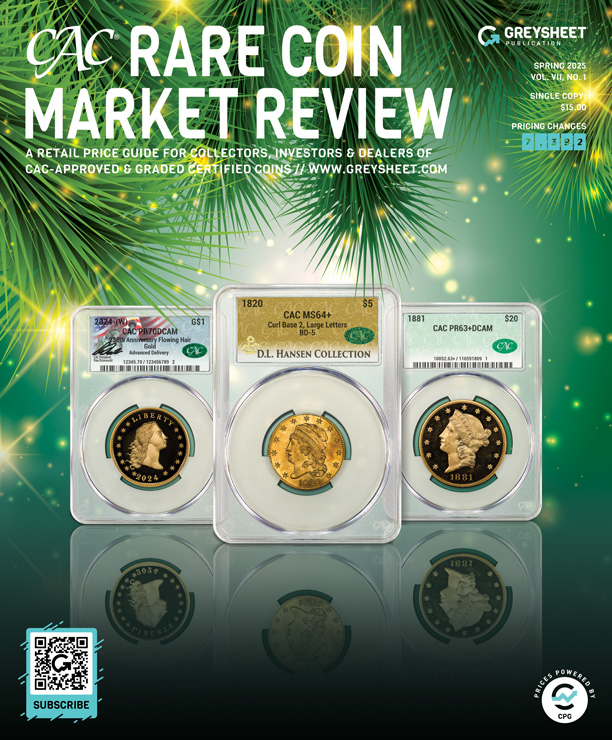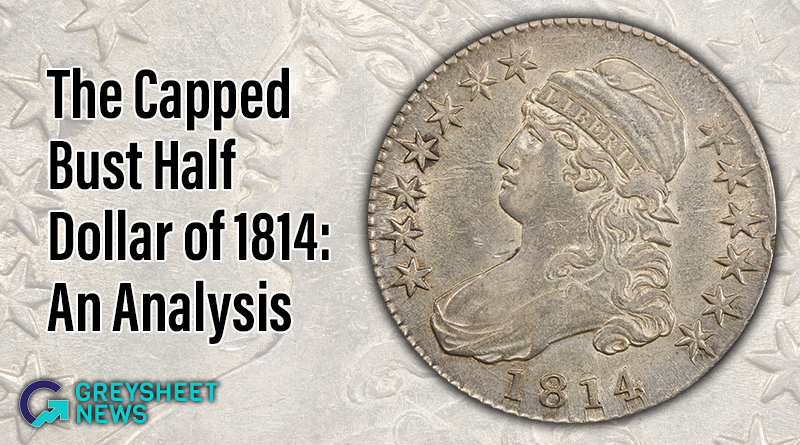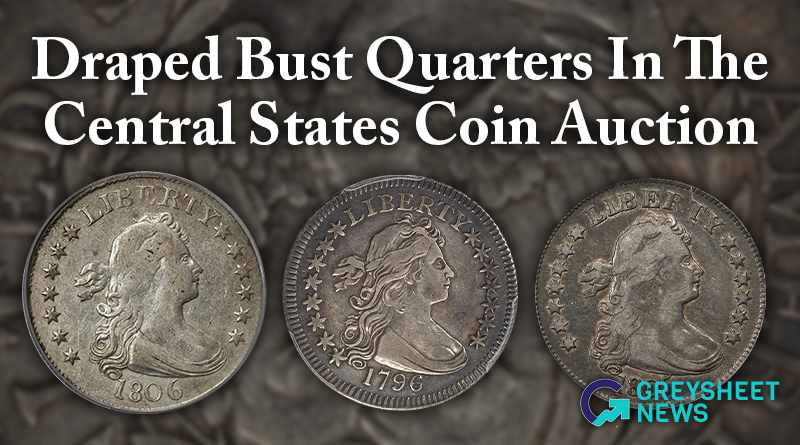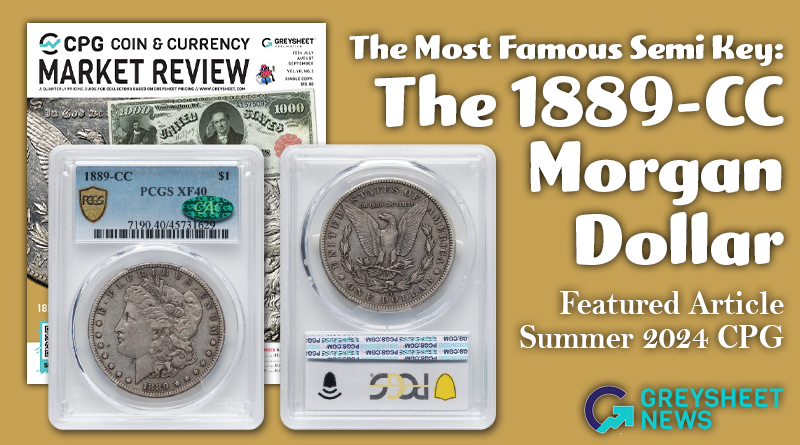The Most Valuable Common Coins are CAC Saint-Gaudens Double Eagles
Anyone can buy a CAC approved gem quality (MS65) Saint, probably a 1924 or a 1928, for less than $4,000. These exist in quantity.
The term “Generic Saints” refers to very common Saint-Gaudens double eagles (U.S. $20 gold coins). The most common generic Saints are the 1908 No Motto, the 1924, the 1927 and the 1928. Though not quite as common, the 1923-D and the 1925 are generics, too. Generic Saints that are CAC approved as grading in the MS67 range have dramatically risen in value since 2020 and have reached mind boggling levels.
Two generic Saints in the Simpson Collection brought tremendous prices at auction on August 22, 2022. Before focusing on these two, there is a need to provide background information regarding generic Saints.
The current CPG®-CAC medium retail price estimate for a CAC approved, PCGS or NGC graded MS65 Saint is $3,620 and the corresponding estimate for a CAC approved MS66 grade coin is $5,880, as of Sept. 12, 2022. These tend to be very attractive coins with neat luster.
In other words, anyone can buy a CAC approved gem quality (MS65) Saint, probably a 1924 or a 1928, for less than $4,000. These exist in quantity. As of Sept. 12, CAC has approved nearly two thousand 1924 Saints as MS65 and more than seven hundred as MS66.
CAC approved Saints in the MS67 grade range are condition rarities. In the MS67 range, CAC reports twenty 1908 No Motto Saints, eleven 1923-D Saints, thirty 1924s, two 1925s, four 1927s and twenty-six 1928 Saints. Also, there are a few CAC approved MS67 grade better date Saints, including absolute rarities, though those constitute a whole different topic. A condition rarity of a very common coin is something much different from a coin that is rare in all grades.
The generic Saints that are PCGS or NGC certified as MS67+ and CAC approved as MS67 have, in several instances, brought many multiples of the values of corresponding coins that were PCGS or NGC certified as grading in the MS66 range or as MS67 without a plus. The current CPG®-CAC medium retail estimate for a CAC approved MS67 generic Saint, presumably for coins without plus grades from PCGS or NGC, is $41,400. which is beyond eleven times the already mentioned CPG®-CAC retail price estimate for a MS65 grade generic Saint, $3,620.
More than half of the Saints that have been PCGS or NGC certified as MS67 or MS67+ are dated 1924 or 1928. On August 22, 2022, in the Simpson session of the recent Heritage post-ANA auction extravaganza, records for 1924 and 1928 Saints were shattered, amazingly so.
To a significant extent, the market for CAC approved MS67 generic Saints has separated itself from the market for non-CAC PCGS or NGC graded MS67 generic Saints, which have been volatile during 2021 and so far in 2022. Values of non-CAC PCGS or NGC graded MS67 Saints seem somewhat tied to markets for MS66 and MS65 grade Saints, which are often traded as commodities rather than as individual coins for collectors. For the most part, CAC approved MS67 Saints are demanded by different buyers. I know a few of the buyers.
Values for CAC approved MS67 grade generic Saints increased by more than 50% from late 2020 to the middle of the summer of 2022. It is difficult to estimate the value of a PCGS or NGC graded MS67+ generic Saint with a CAC sticker. Experts at CAC ignore the plus aspect of plus grades assigned by PCGS or NGC. In terms of market realities, however, many buyers will pay more for a CAC approved MS67+ Saint than for a a CAC approved MS67 Saint, even though experts at CAC may figure the grade of a particular CAC approved PCGS certified MS67+ coin is in the middle rather than the high end of the MS67 range.
As the just mentioned point is a little complicated, it should be restated in a different way to be clearer. In many cases, CAC has placed a CAC green sticker on a PCGS or NGC holder of a coin with a plus grade even though experts at CAC do not or would not agree with the plus grade. While deciding whether the precise grade of a coin is at least in the middle of a whole number grade range, experts at CAC do not pay attention to whether the respective coin was assigned a plus grade by PCGS or NGC. Nonetheless, the combination of a PCGS plus grade and a CAC sticker has much market value in regard to PCGS graded MS67+ generic Saints.
In my view, not that of the CDN-Greysheet editor or publisher, an upper-wholesale price for a CAC approved, PCGS graded MS67+ 1924, 1927 or 1928 Saint, at the beginning of August 2022, was $47,500 and a medium retail price would have been a little more than $60,000. On August 22, the CAC approved, PCGS graded MS67+ 1924 Saint in the Simpson Collection realized $90,000!
As far as I know, the previous auction record for a 1924 Saint was the $63,250 result for a PCGS graded MS68 1924 Saint that was auctioned by Heritage on January 6, 2006. That coin could not then have had a CAC sticker since CAC was founded in 2007. Besides, CAC has not approved any business strike Saints in MS68.
On May 5, 2022, Heritage auctioned a PCGS graded MS67+ 1924 Saint, without a CAC sticker for $45,600. In my view, this was not a good value. At a glance, this coin is apparently superb. Upon close inspection, however, I found blue and orange textures that I really did not like, and imperfections under these textures. This is my opinion. Evidently, there are grading professionals at PCGS who found this 1924 Saint to be a superb coin. Multiple experienced coin professionals may scrutinize the same coin and draw very different conclusions. Should a collector spend a lot of money for a common coin largely because it is highly certified?
On December 16, 2021, Heritage sold a CAC approved MS67 1924 for $34,800, which did not have a plus. I did not see it first hand.
As for the Simpson Collection PCGS graded 67+ 1924, no pedigree or prior auction history is listed in the Heritage catalogue. There are some noticeable contact marks on the obverse in prime focal areas. Is it a realistic possibility that experts at CAC found the grade of this coin to be in the middle of the MS67 range rather than in the high end?
I very much like the neat cartwheel luster and wonderful originality of the Simpson Collection 1924. I just do not perceive it as superior to most other CAC approved MS67 grade Saints, with or without plus assignments from PCGS or NGC. The Simpson 1924 is, however, very much superior to the already mentioned non-CAC, PCGS graded MS67+ 1924 that realized $45,600 on May 5.
In my opinion, there are compelling reasons for the Simpson 1924 Saint to be worth around twice as much as that non-CAC PCGS graded MS67+ 1924 Saint, which was auctioned in May. It does not follow, logically, that either coin should be worth so much more than a MS66 or MS65 grade 1924 Saint.
The Simpson 1928 drew much more attention than the Simpson 1924 Saint. The thick orange toning on the obverse is unforgettable. This 1928 Saint was earlier in the collection of Dr. Steven Duckor, a living legend. In past articles, I covered the offerings of his collections and chronicled Dr. Duckor’s collecting journey. In January 2012, Heritage auctioned Dr. Duckor’s set of Saints, except his former 1927-D, which was auctioned much earlier, by the firm of David Akers in 1998.
Before January 2012, the Duckor 1928 Saint was PCGS graded MS67+, with a CAC sticker, and was so certified when it was auctioned on August 22, 2022, as part of the Simpson Collection. In 2012, it realized $54,625, which was considered an incredibly high price at the time. In January 2012, Greysheet Bid, a high-wholesale price estimate, for a MS67 grade Saint was $7,000.
Unquestionably, the Duckor-Simpson 1928 is an exceptionally entertaining coin. The fields are blonde with green tints. The orange colors in the centers really command attention. On August 22, the $204,000 result was certainly one of the strongest prices in the whole Heritage auction extravaganza. I was figuring that a medium retail price would have been around $140,000.
Regarding the $204,000 result for this 1928 and the $90,000 result for the Simpson 1924, were these two auction records foreshadowed by auction results for the Rollo Fox 1923-D and for the Kutasi-Duckor 1925? As I reported in an issue of The Monthly Greysheet (https://tinyurl.com/RolloSaints), Rollo Fox’s set of Saints was auctioned by Heritage on January 9, 2020. Like the Simpson 1924 and the Duckor-Simpson 1928, the Fox 1923-D was PCGS graded MS67+ with a CAC sticker. In my personal opinion, Rollo’s 1923-D is of higher quality than either of the two Simpson coins. It is simply amazing.
The colors are almost too cool to be true. Assuming they are true, I graded Rollo’s 1923-D as 67.7 on one day and 67.8 on the next. Perhaps no one can fairly assign the same exact grade to each specific coin every time he sees it! In January 2020, I figured that a fair collector price for the Fox 1923-D was then $45,000 and $55,000 would have been a very strong price. The Fox 1923-D realized $72,000 on Jan. 9, 2020. If the Fox 1923-D had been purchased by Bob Simpson in January 2020 and sold on August 22, 2022, it would probably have realized more than $175,000, maybe even $250,000!
On May 5, 2022, Heritage auctioned a CAC approved, PCGS graded MS67 (not 67+) 1925 Saint for $132,000. Though not as extremely common as the 1924 or 1928, the 1925 is a generic, too.
This same 1925 Saint realized $23,000 in January 2007 when it was auctioned as part of the collection of John Kutasi. I was there and I reported on that auction for a leading coin newspaper. On January 5, 2012, it was auctioned as part of Duckor’s set and it realized $29,900. This 1925 Saint thus realized more than four times as much on May 5, 2022 as it did on January 5, 2012. This result, though, is roughly consistent with the Duckor-Simpson 1928 Saint bringing nearly four times as much in 2022 at $204,000 [ha.com link], as it did in 2012 at $54,625.
This $204,000 result is clearly an auction record for a very common coin; more than two hundred thousand 1928 Saints survive. For common coins that are condition rarities, the premiums for CAC approved coins tend to be substantially greater than the premiums for most other CAC approved coins.
Copyright ©2022 Greg Reynolds
Images courtesy of Heritage Auctions, HA.com and
PCGS TrueView, PCGS.com.

Download the Greysheet app for access to pricing, news, events and your subscriptions.
Subscribe Now.

Subscribe to CAC Rare Coin Market Review for the industry's most respected pricing and to read more articles just like this.
Source: Greg Reynolds
Related Stories (powered by Greysheet News)
View all news
In this article Greg Reynolds analyzes the 1814 Capped Bust Half Dollar.

The Lusk set of Draped Bust quarters brought strong results.

The 1889-CC is the second scarcest business strike in the series.









Please sign in or register to leave a comment.
Your identity will be restricted to first name/last initial, or a user ID you create.
Comment
Comments